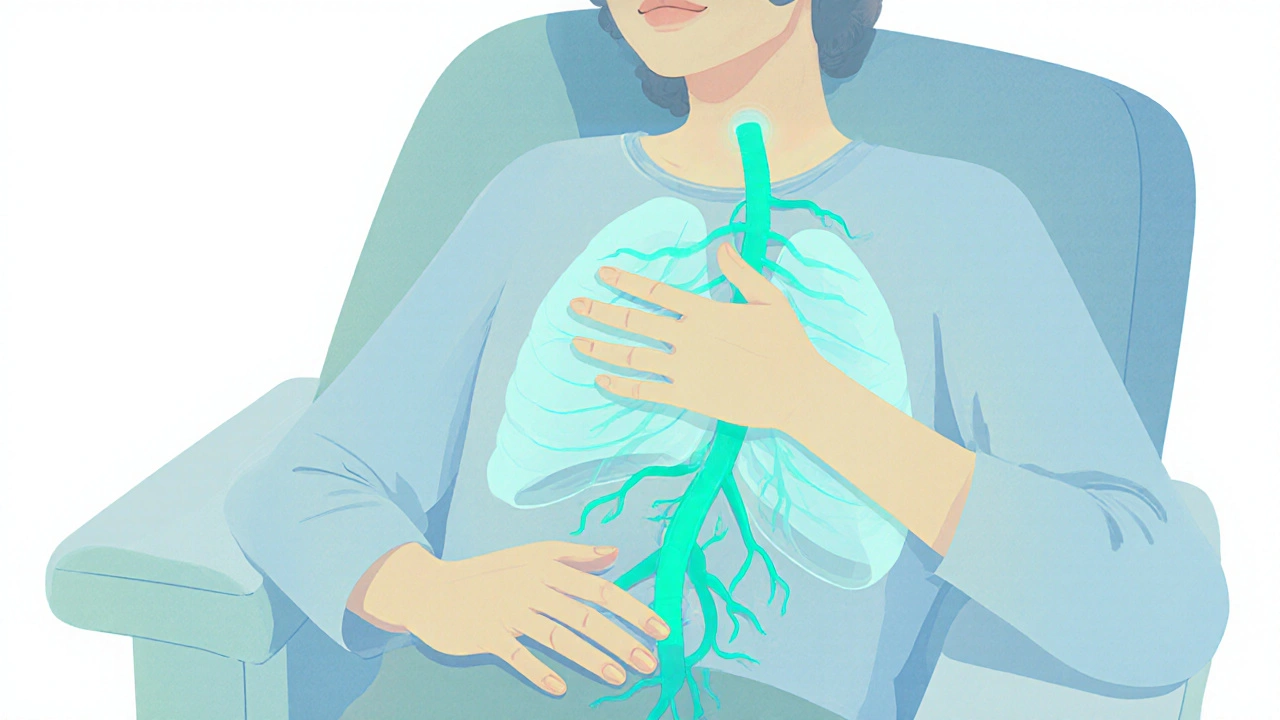Deep Breathing for Dizziness & Motion Sickness
Diaphragmatic Breathing
Best for everyday stress and mild dizziness. Inhale 4 seconds, exhale 6 seconds.
4-7-8 Technique
Great for severe nausea or pre-flight anxiety. Inhale 4, hold 7, exhale 8.
Box Breathing
Ideal for rapid onset vertigo or high-stress situations. Inhale, hold, exhale, hold for 4 seconds each.
Practice Instructions
Choose a technique and cycle count, then click "Start Practice Session" to begin.
Ever felt that sudden spin when you stand up too fast, or the queasy twist of a car ride? You’re not alone-dizziness and motion sickness affect millions daily. The good news? A simple habit you can practice anywhere-deep breathing exercises-can calm the storm inside your head and gut.
Key Takeaways
- Deep breathing activates the vagus nerve, lowering heart rate and stabilizing blood pressure.
- Improved oxygen flow eases the vestibular system’s confusion, cutting down vertigo and nausea.
- Three practical techniques (diaphragmatic, 4‑7‑8, box breathing) can be used in seconds during an episode.
- Regular practice builds a resilience buffer, making future trips or quick position changes smoother.
- Seek medical advice if symptoms persist, are severe, or accompany other warning signs.
What Are Deep Breathing Exercises?
Deep breathing exercises are intentional, slow inhalations and exhalations that fully engage the diaphragm, allowing maximum air exchange in the lungs. Unlike shallow chest breathing, which barely fills the upper lobes, deep breathing draws air down to the lower lungs, boosting oxygen saturation and sending calming signals to the brain.
Why Do Dizziness and Motion Sickness Occur?
Dizziness is a broad term covering sensations like light‑headedness, vertigo, or feeling off‑balance. It often stems from a temporary dip in blood pressure, reduced cerebral blood flow, or a mismatch between visual, vestibular, and proprioceptive cues.
Motion sickness arises when the inner ear’s vestibular system detects movement that the eyes don’t confirm (or vice‑versa), triggering nausea, cold sweats, and a headache. Both conditions share a common thread: the autonomic nervous system (ANS) overreacts, spilling stress hormones and tightening muscles.

How Deep Breathing Calms the System
The magic lies in the vagus nerve, the primary conduit of the parasympathetic branch of the ANS. When you breathe slowly and deeply, the vagus nerve receives a signal to release acetylcholine, which slows heart rate, dilates blood vessels, and reduces cortisol. The result is a steadier blood pressure and a clearer flow of oxygen to the brain.
At the same time, deep breaths increase oxygen saturation, which helps the vestibular apparatus reset its equilibrium calculations. Better oxygen means the inner ear’s hair cells fire more accurately, cutting down the conflicting signals that fuel motion sickness.
Three Easy Breathing Techniques
| Technique | Pattern (seconds) | Best For | Duration |
|---|---|---|---|
| Diaphragmatic Breathing | Inhale 4 - Exhale 6 | Everyday stress, mild dizziness | 5‑10 mins |
| 4‑7‑8 Breath | Inhale 4 - Hold 7 - Exhale 8 | Severe nausea, pre‑flight anxiety | 3‑4 cycles |
| Box Breathing | Inhale 4 - Hold 4 - Exhale 4 - Hold 4 | Rapid onset vertigo, high‑stress environments | 4‑6 cycles |
Step‑by‑Step Guide to Use Breathing During an Episode
- Find a comfortable sitting or standing position. If you’re in a moving vehicle, place your back against the seat.
- Place one hand on your chest and the other on your belly. This helps you feel the diaphragm’s motion.
- Choose a technique that feels natural. For quick relief, try Box Breathing.
- Begin the pattern:
- Inhale slowly through the nose for the count indicated, expanding your belly.
- Hold the breath (if the technique calls for it) while keeping shoulders relaxed.
- Exhale gently through pursed lips, feeling the belly deflate.
- Repeat for the recommended number of cycles. Notice the dip in heart rate and the lessening of the spinning sensation.
- When the episode subsides, transition to a few minutes of normal breathing to keep the ANS balanced.

When to Seek Professional Help
Breathing can be a powerful first‑line tool, but it isn’t a cure‑all. Consider medical evaluation if you experience any of the following:
- Sudden, severe vertigo that lasts more than a few minutes.
- Loss of consciousness, chest pain, or shortness of breath unrelated to anxiety.
- Persistent nausea despite repeated breathing attempts.
- Underlying conditions such as Meniere’s disease, vestibular migraine, or cardiovascular issues.
Doctors may recommend vestibular rehabilitation, medication, or further diagnostic tests. Deep breathing can complement these treatments, not replace them.
Building a Daily Breathing Habit
Consistency turns a quick fix into lasting resilience. Try these tricks:
- Set a reminder on your phone for three minutes each morning-use Diaphragmatic Breathing while sipping coffee.
- Pair breathing with activities you already do, like brushing teeth or waiting for the kettle to boil.
- Log episodes in a simple notebook: note the trigger, technique used, and how quickly relief arrived. Patterns will emerge, helping you anticipate future bouts.
- Teach a family member or friend the same steps. Shared practice reinforces accountability.
Within weeks, many people report fewer dizzy spells and a calmer reaction to travel, elevators, or crowded spaces.
Frequently Asked Questions
Can deep breathing replace medication for motion sickness?
Breathing can lessen mild to moderate symptoms and is a safe adjunct, but if you routinely need antihistamines or scopolamine, discuss a combined plan with your doctor.
How long should I practice each technique?
Start with 3-4 cycles for Box Breathing or 5‑minute sessions of Diaphragmatic Breathing. Increase gradually as comfort grows.
Is it safe to breathe deeply while driving?
Yes, as long as you keep the technique simple (e.g., 4‑4‑4‑4 box breathing) and maintain awareness of road conditions.
What’s the difference between diaphragmatic and abdominal breathing?
They’re essentially the same; both emphasize expanding the belly rather than the chest, ensuring the diaphragm does the work.
Can children benefit from these breathing exercises?
Absolutely. Simple games like “blow up a pretend balloon” teach diaphragmatic breathing and can soothe motion sickness on rides.








Comments
If you're dealing with that spinning feeling or the queasy twist on a bus, the simplest tool is your own breath. Diaphragmatic breathing, the 4‑6 pattern, gets oxygen to the vestibular system quick. The 4‑7‑8 technique adds a hold that ramps up vagal tone, perfect for severe nausea. Box breathing's symmetrical rhythm stabilises heart rate and can calm rapid‑onset vertigo. Practice these for a few minutes a day and you'll build a buffer that reduces episodes dramatically.
The article tries to sell you on the idea that a few seconds of conscious inhalation can fix what many doctors would attribute to complex vestibular disorders, which is, frankly, a bit ambitious; you might think that simply counting to eight while exhaling will magically rewire your inner ear, but the human body rarely obeys such simplistic scripts. Still, the author presents a tidy three‑step menu – diaphragmatic breathing, the 4‑7‑8 technique, and box breathing – each framed as a panacea for dizziness, motion sickness, and even, dare I say, existential dread. The claim that deep breathing "activates the vagus nerve" is not without merit, as slow respiration does indeed increase parasympathetic tone, yet the nuance of neurophysiology is glossed over in favor of catchy bullet points. Moreover, the piece emphasizes that these practices can replace medication, which is a dangerous oversimplification; while breathing can mitigate mild symptoms, it is not a substitute for antihistamines when needed. The instructional section includes a handy interactive component, complete with timers and cycle counters, but the user experience may suffer from a cluttered UI that distracts from the core message. In the table, the author lists duration and best‑for scenarios, but the numbers seem arbitrarily chosen – why is box breathing limited to 4‑6 cycles? Might have been better to discuss the underlying physiology rather than just presenting a recipe. The article also glosses over contraindications; people with certain cardiac conditions should consult a professional before engaging in breath‑holding exercises. The suggestion to "log episodes" is practical, yet the article fails to provide a template or digital tool for doing so. The tone swings from clinical to motivational, which can feel disjointed – one moment you get a detailed explanation of the vagus nerve, the next you see an emoji‑filled pep talk. The language, while accessible, occasionally slides into jargon (“vestibular apparatus”) without sufficient definition for lay readers. The FAQs section, while helpful, repeats information already covered in the main body, adding redundancy rather than depth. Finally, the article's concluding advice to practise regularly is sound, but the claim that "within weeks many people report fewer dizzy spells" lacks citation. In short, the piece is an enthusiastic primer on breathing techniques, but it should be read with a critical eye and not taken as a comprehensive medical guide.
Sure, you can try the breathing tricks, but remember the body is a stubborn beast. Anyway, give the 4‑7‑8 a shot; you might actually feel less dizzy.
I think the main idea is solid, but some people still think deep breathing is just a gimmick. In reality, it does shift your autonomic balance, even if you don't realy notice it at first. Keep practising, and you'll definetly see less spin. Also, stay hydrated, that helps too.
Whoa, this is gold! 🙌 Try the box breathing next time you're on a roller coaster, and watch the nausea fade 🌟 Keep it up, you'll be a motion‑sickness ninja in no time 🚀
Ah, the melodramatic allure of controlled respiration! One must envision the breath as a symphonic crescendo, each inhalation a violin, each exhalation a cellos' sigh. Only then does the vestibular apparatus submit to the maestro’s baton, and the dreaded vertigo retreats like a humbled audience. Such elegance, rarely observed in the pedestrian masses.
Great points, everyone! 🌈 Remember, consistency is the secret sauce-set a daily reminder and stick to it. If you stumble, just breathe again and keep moving forward. You've got this! 😊
Honestly, you all sound like you're talking about a hobby, not a health issue. Maybe you should just see a doctor instead of playing with breathing games.
Your sentence should start with a capital letter and end with a period.
I totally agree with the need for regular practice, and I'd add that sharing your progress in a group chat can keep you accountable. Also, try pairing breathing with a simple stretch; it feels good. Let's keep each other motivated!
One might argue that the very act of breathing is a metaphor for life's endless cycles, each inhale a birth, each exhale a death. In that sense, combating motion sickness becomes a quest for existential equilibrium. Yet, the universe remains indifferent to our vestibular woes, offering no grand revelation. Still, the humble breath can be a quiet rebellion against chaos. Perhaps that is enough.